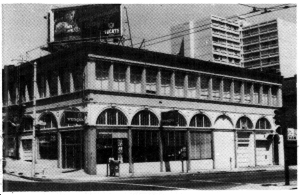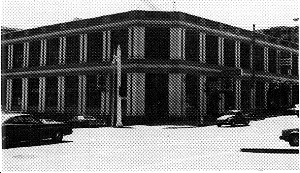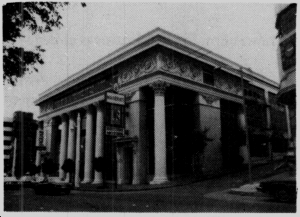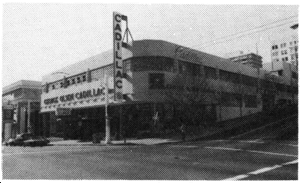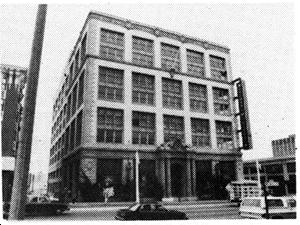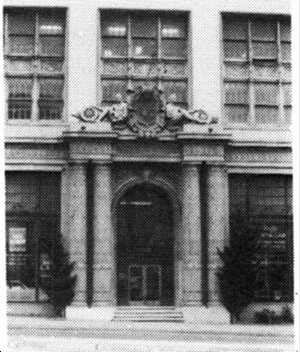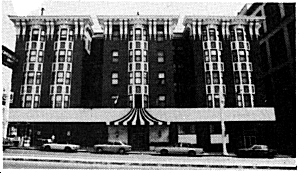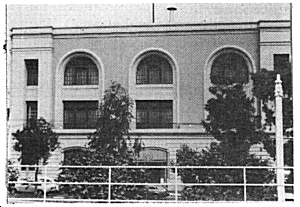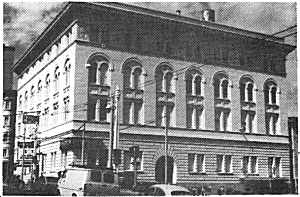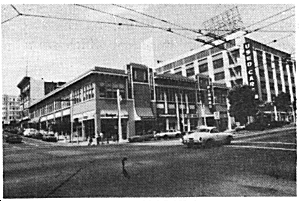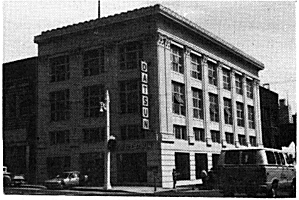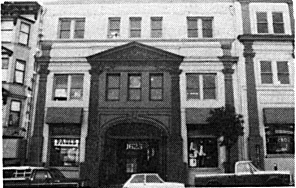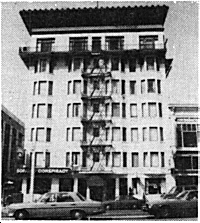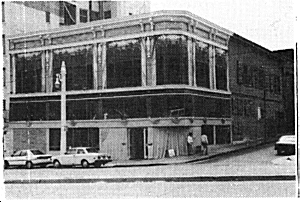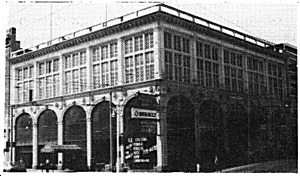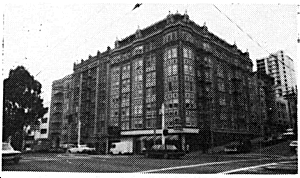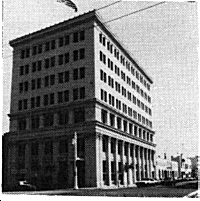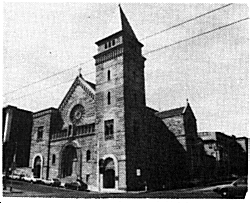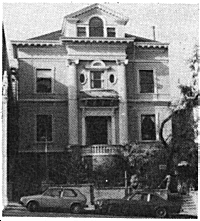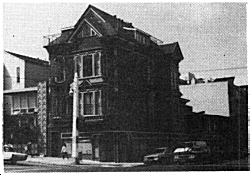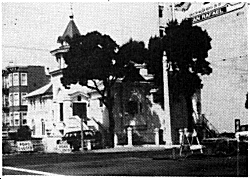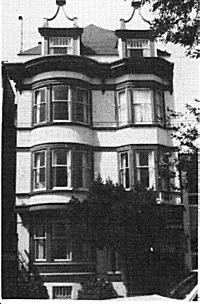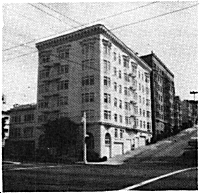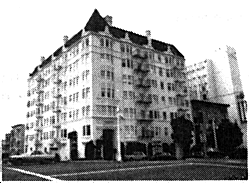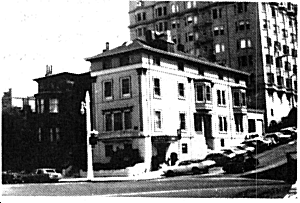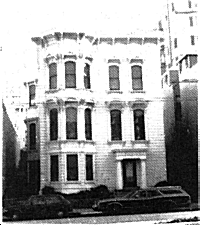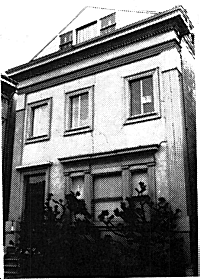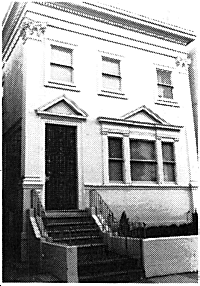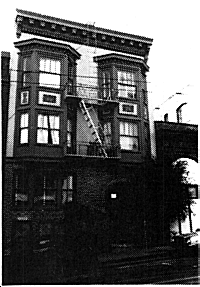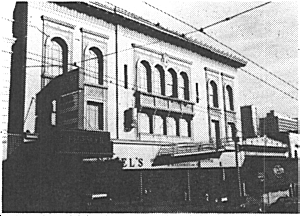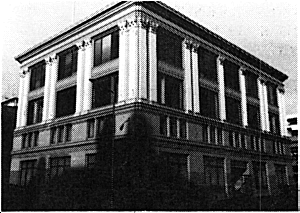|
|
|
Planning Home > General Plan > Van Ness Avenue Area Plan
Van Ness Avenue Area Plan
History In 1849, William Eddy extended the 50 Vara land division of the downtown to Larkin Street, replicating street and block dimensions created by earlier surveys of Jean Vioget and Jasper O’Farrell.¹ The Western Addition, as the sand dunes and chaparral west of Larkin were called, was subsequently surveyed by several private groups before the city-sponsored Van Ness Survey was completed in the mid-1850’s. Originally known as Marlette Street, the centerpiece of this extended 50 Vara survey was re-named in honor of Mayor James Van Ness. Situated in the valley between Nob and Russian Hills and Pacific Heights, Van Ness Avenue was intended to function as the city’s central north-south spine. Consequently, the survey shaved off parts of the blocks on both sides of Van Ness to create a 125 foot wide avenue.² Despite grand hopes for the new Boulevard, development of properties along the avenue was slow and the U.S. Coast Survey of 1869 indicated only scattered structures. In the 1860’s Van Ness began at Market Street and terminated at the U.S. military reserve at Black Point. Since principal growth corridors radiated out from the downtown, it was a long time before cross-town streets such as Van Ness could become important arteries. The 1884 Coast and Geodetic Survey shows buildings concentrated along intersecting streets with cable car lines such as Fulton, McAllister, Ellis and Geary. Throughout this period, Polk Street, rather than Van Ness, functioned as the principal commercial street of the mid-city, serving people living on Nob and Russian Hills. It is conceivable that the width of Van Ness — like that of Market Street — discouraged its use as a shopping street. Thus, as opposed to the heterogeneous development of the avenue in the twentieth century, the nineteenth century land pattern primarily consisted of wooden dwelling units. While lower Van Ness Avenue was soon occupied by dense working class housing, the middle and upper reaches of the avenue became characterized by wealthy residences. Italianate homes were constructed during the 1870’s and 1880’s, and were followed by large Queen Anne residences in the 1890’s. Prominent families who owned homes on Van Ness included the Spreckels, Crockers and Gianninis. Aside from residences, the only large buildings shown on the 1899-1905 Sanborn Maps were the Mechanics Library, Concordia Club, St. Lukes Episcopal Church, First Presbyterian Church and St. Dunston’s Hotel. Livery stables, small industries, a school and other miscellaneous uses were located side streets. Industrialization of Rincon Hill — caused by the Second Street Cut of 1869 — and shortage of available land on Nob Hill encouraged the development of a new high-income neighborhood, and Van Ness Avenue became a logical choice largely stimulated by proximity to downtown, availability of undeveloped parcels, and access to cable car lines. Furthermore, in the mid-1870’s a row of Eucalyptus trees was planted along each side of the avenue, contributing to its park-like ambience. For similar reasons, large houses were also constructed during the same period on Franklin Street, a block to the west. Van Ness Avenue’s basic land use pattern continued until 1906. The earthquake and fire of that year destroyed most of San Francisco and would likely have gone on to burn Pacific Heights had it not been for the great width of Van Ness Avenue, a natural fire break. During the first day of the fire soldiers had attempted fire breaks further east of Van Ness Avenue, all of which proved unsuccessful. They tried again at Van Ness on the second day, dynamiting every building on its east side south of Filbert Street, containing most of the fire and saving the Western Addition: the area between Sutter and Washington Streets was not contained until Franklin Street, and the area south of Golden Gate Avenue was not contained until Octavia Street. Immediately after the fire, burned out businesses from the downtown moved to either Van Ness Avenue and Fillmore Street. Surviving mansions on the west side of Van Ness were converted into stores, and temporary commercial buildings were quickly constructed on the east side of the street. The city’s major department stores — City of Paris, the White House, and the Emporium — all located here, as did the Bank of California and the Anglo California Bank By 1909, however, the rejuvenation of the downtown district led to the exodus of businesses from Van Ness Avenue, the second transformation of the avenue’s land use pattern in less than three years. Far from returning to its earlier history as a residential boulevard, development along the lower and middle sections of Van Ness consisted of residential, commercial, industrial as well as institutional uses. The 1911 Sanborn Map illustrates the heterogeneous uses — including auto body, wagon and bicycle repair shops — as well as numerous undeveloped sites. A National Guard Armory was located at the southeast corner of California Street while clubs and hotels were scattered along the mid section of the avenue. In contrast to these areas, the upper section of Van Ness, north of Jackson Street, retained its residential character. In addition to several surviving nineteenth century mansions, private homes and large apartment buildings in a wide variety of architectural styles were constructed following the 1906 disaster. After 1915 and the Panama Pacific Exposition, residences were constructed along Van Ness north of Francisco Street. By the 1920’s — aside from several large apartment buildings — automobile-oriented businesses emerged as the most common use between Civic Center and Jackson Street. Earlier, between 1904 and 1908 many small auto showrooms and garages were built along Golden Gate Avenue between Hyde and Van Ness, and after 1910 several small showrooms and repair garages located on Van Ness itself. The growing automobile industry soon demanded more grandiose buildings, and by 1911 prominent architects such as McDonald and Applegarth, Willis Polk and Bernard Maybeck began designing automobile showrooms. After the Second World War, the designation of Van Ness as U.S. Highway 101 led to the use of the avenue as a primary vehicular thoroughfare and the concurrent re-orientation of businesses towards citywide and regional markets. Movie theaters and restaurants opened up alongside automobile showrooms. Since the late 1970’s, automobile-oriented businesses have declined as some auto showrooms relocated to other areas within the city. Former auto showrooms have been converted to restaurants and offices, and some have been demolished for new mixed use residential developments. Given the relocation of the auto showroom businesses and ancillary auto service and parts businesses, a number of properties will likely be available for new development or adaptive re-use in the near future. ¹A cellular unit, known as Vara, provided a set of dimensions which allowed for grid expansion throughout the South of Market and northern part of San Francisco. In the latter area, the 50 Vara survey consisted of blocks measuring 412’6" by 275', or six 50 Vara squares whose sides measured 137’6". Street widths were commonly 25 Vara, or 68’9", although this varied considerably. ²The creation of a 125' wide boulevard out of a 68’9" street necessitated shaving off parts of the blocks on either side of Van Ness. Thus, 28’9" was taken from the block extending to Polk Street and 27’9" was garnered from the western block extending to Franklin Street. The choice of 125 feet for Van Ness may have been influenced by the widths of major streets in eastern cities, such as Broadway in New York and Market Street in Philadelphia.
LAND USE SUBAREA 1: Redwood to Broadway OBJECTIVE
1 Although there are 18 buildings containing 980 dwelling units in this subarea most of the buildings are in non-residential use. This section of Van Ness Avenue is one of the few areas in the city where new housing can be accommodated with minimal impacts on existing residential neighborhoods and public services. Some of the features that make the area attractive for medium density mixed use development with high density housing are as follows: This 16 block strip along Van Ness Avenue maintains a "central place" location and identity. The area is close to the city’s major employment center, is well-served by transit, has well developed infrastructure (roadway, water, sewer and other public services), wide roadway (93+ feet) and sidewalks (16+ feet), has continuous commercial frontage and numerous attractive, architecturally outstanding buildings. There are a number of large parcels which are substantially under-developed. A height limitation of between 80 and 130 ft. would allow sufficient development to make feasible over time the construction of housing on under used parcels. The minor streets which bisect most of the blocks within this subarea facilitate access to and from new developments with minimal affects on major east-west thoroughfares or on Van Ness Avenue. Development of a number of medium density, mixed-use projects with continued non-residential use of non-residential buildings would facilitate the transformation of Van Ness Avenue into an attractive mixed use boulevard. POLICY 1.1 Construction of new mixed use buildings along the Avenue on those relatively few sites on which new buildings are likely to be built in the foreseeable future would both accommodate the need for housing and respect the commercial heritage of the Avenue. Subarea 1 (Redwood Alley to Broadway) should feature high density residential development with commercial space to occupy the base of the building. This commercial space should serve as a buffer between the busy street and the residential levels above. To induce the construction of housing, link the amount of non-residential space allowed should be linked to the amount of residential space provided. The provision of the required residential space could occur on-site or on a separate site located within the Van Ness Plan area. POLICY 1.2 In order to continue the active commercial use of the avenue, existing non-residential buildings should be permitted to contain any use — residential or non-residential — allowed in the district. These buildings should also be allowed to be expanded somewhat without triggering the housing requirement. Non-residential development of narrow lots that do not also abut a side street should also be allowed because of the difficulty in providing residential parking on those properties. POLICY 1.3 The number of units provided within individual projects would depend on the height and bulk of the building, the amount of commercial space provided under the minimum housing-to-commercial ratio, the amount of on-site parking provided and the size of the units. Minimum unit size would be established as part of the Conditional Use review process. POLICY 1.4 An overall mix of unit sizes on Van Ness Avenue is desirable to encourage a diverse and mixed range of occupants. However, the emphasis should be on a larger number of medium sized units (1 and 2 bedroom) rather than a smaller number of large size units because Van Ness Avenue is not anticipated to be a preferred area for family housing. It is therefore more desirable to achieve greater affordability for the smaller units by building at a high density. Construction of rental housing is encouraged. POLICY 1.5 The Plan allows broad design flexibility as to unit size, allowing the creation of small, compact units as a means of lowering unit cost if there is a market demand for such units. A number of design measures and marketing strategies such as "street-facing" or "no view" units and units with quality building materials yet lower cost appliances and carpeting can reduce unit costs and prices. SUBAREA 2: Broadway To Bay Street OBJECTIVE
2 POLICY 2.1 New development in this area should be restricted to residential use with neighborhood-serving retail use allowed at the ground floor. This would involve reclassifying properties from to medium density residential with ground floor retail use. Existing small scale commercial uses above the ground floor should be permitted to remain as non-conforming uses for the life of the building. Existing ground floor residential space could be converted to small-scale retail use provided that upper level residential space and its required accessory uses (e.g. parking, open space, rear yard, access ways, other mechanical features) were not adversely affected by such conversion. SUBAREA 3: Bay Street To The Municipal Pier OBJECTIVE
3 POLICY 3.1 This greenspace element, which would realign some existing parking spaces, should be designed to "announce" the area’s attractive shoreline open space resources and visually direct the visitor to them. POLICY 3.2 The GGNRA General Management Plan calls for the following improvements: "All of the Van Ness Avenue (asphalt paving) inside the park boundary will be removed and replaced with landscaping. The Sea Scout clubhouse and maintenance docks will also be removed. The Sea Scouts’ boats will be moved to the east side of the lagoon, and their programs and meetings will be held in the aquatic center. The food concession at the foot of Van Ness will receive a good sprucing-up. The Municipal Pier will also get a substantial cleanup and minor improvements such as fish- cleaning stations and restrooms. (It may also require structural renovation). Night lighting throughout the area will be upgraded." VAN NESS CORRIDOR OBJECTIVE
4 POLICY 4.1 OBJECTIVE 5 Topography and Street Pattern Van Ness Avenue is the central north-south spine and one of the widest streets in the City. Bounded by Civic Center and the Bay and characterized by excellent views, the Avenue defines and links many adjacent neighborhoods. In connecting Market Street to the Bay, Van Ness forms the western edge of the inner city and separates the Nob and Russian Hill neighborhoods from Pacific Heights. The Avenue also provides access between a number of focal points, including landmark buildings, cultural centers, important view corridors and the Bay. The juxtaposition on the Avenue of large monumental structures with fine-grain urban fabric to the east creates an exciting contrast within the cityscape. POLICY 5.1 Existing height limits on the Avenue range from 40 feet at the northern end to 130 feet in the central portion. This height differentiation responds to topographic conditions as well as land use patterns, maintaining distinctions between areas of different character. For example, height districts are gradually tapered from 130 feet around the hilltop at Washington Street to 80 feet at Pacific Avenue and further to 65 and 40 feet towards the Bay shoreline. Although the majority of existing height controls are adequate to define both the overall topography as well as the great width of the Avenue, the height limit between California and Pacific Streets should be lowered from the existing 130/105-ft. level to 80 ft. in order to facilitate the transition between the greater building heights along the southern part of the Avenue and the mostly low-rise residential development north of Broadway. Development to maximum height should be closely monitored to avoid blocking views between the high slopes on both sides of the Avenue. Good proportion between the size of a street and that of its buildings is important for streets to be interesting and pleasant places. The proposed height limits, combined with the Van Ness Plan’s proposed bulk controls, encourage definition of the 93-foot wide Avenue. POLICY 5.2 New development should create a coherent street wall along the Avenue through property line development at approximately the same height. Since block face widths are constant, a regularized street wall encourages buildings of similar scale and massing. Nevertheless, some variety of height is inevitable and desirable due to the need to highlight buildings of historical and architectural significance. The following controls are proposed for the various bulk districts as shown on the accompanying map: Setbacks POLICY 5.3 New construction on Van Ness Avenue can occur in two basic situations. In some cases, the development will take place between or adjacent to architecturally significant buildings. In this instance, continuity of design and scale between the old and the new is of major importance. In other cases, new development will take place in a more isolated design context; for example, between two existing two-story, non-descript commercial structures. In this instance, the overall continuity of scale along the Avenue is of greater importance than the design character of adjacent buildings. Setbacks of up to 20 feet in depth should be considered for all new development above 40 feet in height and should be required whenever necessary to continue existing significant street wall heights and to define an adequate enclosure of the Avenue. Setbacks can also serve to buffer the upper-level residential units from street-level noise. POLICY 5.4 In addition to the setback along the Van Ness Avenue frontage, a setback approximately fifteen feet deep should be provided at an appropriate height along California, Pine, Sacramento, Clay and Washington Streets when necessary to preserve view corridors. The recommended setbacks on the east-west streets could be varied on a case-by-case basis, through the Conditional Use review process, as individual buildings undertake massing studies to determine an appropriate building form and setback which would preserve these significant view corridors. Rear Yards POLICY 5.5 Modifications of the rear yard requirement should be allowed if a comparable amount of usable open space is provided elsewhere within the development, if any interior block open space formed by the rear yards of abutting properties is not adversely affected, and if adequate light and air to all dwelling units is maintained. Minimum Distance Between Towers POLICY 5.6 In a project involving more than one tower, the towers should be separated so they are viewed as separate structures, thereby reducing their apparent bulk. When towers lack adequate physical separation and differentiation of building materials, texture coloration or massing, they can be perceived as a single structure and the purpose of the bulk requirements is defeated. In addition, building separation allows greater light and air exposure to individual housing units and commercial spaces. OBJECTIVE
6 Building Form and Design Architecturally significant structures along Van Ness Avenue impart a sense of visual unity, although they are characterized by a great stylistic variety. In contrast, undifferentiated buildings can be overwhelming, creating an inhospitable pedestrian environment. Differentiation of building sections — including setting off a building base from shaft and tower — creates a human scale at street level. POLICY 6.1 Architectural styles along the Avenue include Romanesque, Gothic, Spanish Colonial, Renaissance/ Baroque, Beaux Arts Classical, and Modern. Such architectural variety precludes the predominance of any one style, even though the Beaux Arts is clearly dominant in Civic Center. While design in a historical style is neither encouraged nor discouraged, the eclectic styles of significant buildings provide a rich architectural vocabulary. POLICY 6.2 The 50 Vara block subdivision along Van Ness Avenue results in north-south block lengths of 275 feet. On blocks bisected by alleys the length is commonly 120 feet. Excessive horizontal width without recurring vertical elements leads to a repetitive rhythm difficult to comprehend. POLICY 6.3 Design features such as setbacks and wind breaks on new developments and renovations can help to provide a pleasant environment on both rooftops, sidewalks, courtyards and nearby open spaces. POLICY 6.4 Defined bases on tall buildings provide opportunities for active ground floor uses, ornament and art, colonnades, arcades and their innovative schemes. Clear glass facilitates visual contact between the building and the outside and is especially important at the ground level. A belt course or cornice, change in materials, or other architectural treatment should be required at the 40 to 60 foot height along Austin, Hemlock and Fern Streets for properties with frontage along those minor streets. POLICY 6.5 Pedestrian bridges block views, shadow streets and other open spaces and obstruct skyline elements while only marginally improving private pedestrian circulation between buildings. Safe and convenient pedestrian circulation at grade is preferred. OBJECTIVE 7 Safety, Security and Privacy POLICY 7.1 Common areas associated with the residential portion of a mixed use development should be designed to prevent intrusion by commercial space users and the general public. Whenever possible, residential parking areas should be physically separated from public parking areas and should provide safe and secure passageway to residential elevators and walkways. Handicapped parking areas should be placed close to elevators and should be free of potential vehicle movement conflicts. Sun, Shade and Wind Protection POLICY 7.2 Open Space/Greenspace POLICY 7.3 The requirement of 36 square feet of open space for each dwelling unit should continue to apply. Development of common usable open space could substitute for private open space at a ratio of 1.33 to 1 provided that this space would be for the exclusive use of project residents. Common open space should include such uses as multipurpose rooms to be used for exercise rooms, solaria, recreational facilities, green spaces and open space play areas. Noise POLICY 7.4 There are a variety of ways in which the sound coming from Van Ness Avenue can be reduced to create an acceptable acoustic environment for dwellings. Setbacks provided above the commercial street wall can serve as a sound barrier for those units behind the setback. In addition, noise control for interior spaces can be provided through sound-rated windows. Other sound attenuation measures such as deep balconies and solid balcony rails may also be necessary. Bedrooms or whole units can be insulated from noise by solaria which provide not only sound insulation but also usable garden space, and, on the south, solar heating. To encourage their use, solaria should be counted as required private, usable open space if they are designed so that a substantial portion of the window area can be opened to the air. OBJECTIVE 8 Plantings POLICY 8.1 Sidewalk vaults or sub-sidewalk basements should not be permitted in new developments. Where there are existing sidewalk vaults or sub-sidewalk basements, project sponsors should be required to install or pay for the installation of subsurface footings, supports or foundations as may be required for future public improvements such as street trees, lights, trolley wire poles, signs, benches, transit shelters, etc. within the vault or sidewalk basement area. POLICY 8.2 Trees should be planted on center two feet from the curb, an average of 20 foot spacing along Van Ness Avenue. At major intersections, the trees might be grouped. Trees should be planted within the sidewalk or median space and should be at least four-inch caliper, 10 feet tall, have good taper, and be free of disease and pests. Appropriate trees for planting in the median strip include Eucalyptus calophylla v. ‘Hawkeye’, Eucalyptus rudis (Desert Gum), and Eucalyptus polyanthemus (Silver Dollar Gum). Appropriate sidewalk canopy trees include two Lindens, Tilia cordata, and Tilia tomentosa, and Platanus acerifolia, Sycamore. POLICY 8.3 The design of the tree grates should be uniform throughout the length of the street. POLICY 8.4 Shrubs or hedges growing to a maximum height of three feet should be planted in addition to or in lieu of ground cover within the median strip. Ground cover species could include Agapanthus africanus (Lily of the Nile), Dwarf Lily of the Nile, as well as colorful Gazania, consistent with other plantings in the median along Van Ness. Sidewalk Treatment POLICY 8.5 POLICY 8.6 Sidewalk and median strip paving materials should be concrete, light grey-tone in color, with a plain, brushed surface texture, except for a darker grey 12-inch curbside trim which should add a richness in color and texture to the Avenue. POLICY 8.7 The stone pavers should be of a complementary medium grey-tone color (e.g., Hanover Prest Paving R.D. No. 4). Street Lighting POLICY 8.8 Painting all the light poles along Van Ness Avenue a blue and gold color scheme, similar to that of the Civic Center light poles, would contribute to this special identity. If feasible, existing street light poles should be maintained and enhanced in order to contribute to the special identity of the Avenue. The angle and color of illumination on existing and new street lights should be designed to minimize glare to nearby residential uses. Lighting should not damage adjacent landscape plantings and should provide safe and attractive lighting for pedestrians. Street Furniture POLICY 8.9 New bus shelters or replacement shelters should be placed between the trees along the tree line of the sidewalk. Benches should be attached to the ground and located between the trees along the tree line of the sidewalk adjacent to bus stops. POLICY 8.10 News racks should be fixed to the ground and not attached to utility poles, or other street furniture; racks should not, as a clustered group, exceed six feet in length; and should provide an adequate visual clear zone at intersections for motorists’ turning movements and adequate space within the sidewalk for free flow pedestrian circulation. Newspaper racks should be clustered only at the intersections in the sidewalk space at the following locations along Van Ness Avenue and would not be allowed elsewhere.
Signs POLICY 8.11 Signs should not feature any flashing, blinking, fluctuating or otherwise animated light. Likewise, signs should not feature any moving parts. Wall signs shall not be less than 10 feet above grade and should not be higher than 45 feet above grade and should not be higher than the lowest residential window sill. Projecting signs and general advertising signs should not be higher than 36 feet. Projecting signs shall in no case project more than 4 feet over the sidewalk. General advertisement signs should conform to State Outdoor Advertisement regulations requiring that no advertising display shall be placed within 100 feet from another advertising display. Signs should not be placed in front of windows.
OBJECTIVE
9 The Van Ness Avenue right of way performs many functions. It is a primary state highway carrying heavy auto and truck traffic. Two Municipal Railway routes — the 47 and 42 lines — travel most of its length as do Golden Gate transit buses. Appropriate measures are required to make certain this traffic flows smoothly. Measures must also be taken to assure that the sidewalk remains pleasant for the pedestrian and that the street will be as attractive a "front yard" for Van Ness Avenue residents as possible. Transit Service POLICY 9.1 POLICY 9.2 POLICY 9.3 POLICY 9.4 This would create a loop rail transit line around the northeastern quadrant of the city. Although expensive to construct, a Van Ness subway would improve intercity and intra-regional transit service and would ease vehicular traffic flow above ground. Auto Circulation POLICY 9.5 POLICY 9.6 POLICY 9.7 POLICY 9.8 POLICY 9.9 The use of these spaces for parking could be a highly desirable adaptive re-use of these buildings, a number of which are to be preserved under this Plan. Access to the parking should be from the side streets, not Van Ness. Pedestrian Circulation POLICY 9.10 Sidewalk space along Van Ness Avenue is shared by pedestrians, transit patrons, sidewalk elevators, light fixtures, MUNI power poles, traffic signals, news racks, benches and street trees, and moving vehicles entering or exiting an on-site parking area. Design of sidewalk space associated with new development should reduce clutter and pedestrian obstacles. Existing sidewalk elevators should be removed as quickly as possible and they should be prohibited in new developments. The number of news racks should be kept to a minimum to improve the free flow of pedestrian activity. news racks should be maintained in an attractive fashion. POLICY 9.11 In addition to providing parking access for new developments fronting on Van Ness, the east-west minor streets should provide safe and attractive pathways for pedestrian travel. Major residential entrances should be designed very graciously and should front major east-west streets. Commercial entrances should be featured along Van Ness Avenue. POLICY 9.12 Freight Loading POLICY 9.13 Whenever possible, access to on-site freight loading spaces should be provided from minor or collector streets rather than from major thoroughfares. In instances where commercial uses front on Van Ness Avenue without convenient access to an off-street freight loading facility, priority should be given to allocating existing curb space on nearby east-west collector streets to truck loading zones. No parking rules for bus zones should be strictly enforced.
PRESERVATION OF HOUSING RESOURCES OBJECTIVE
10 POLICY 10.1 Existing housing is an important source of affordable housing and rental housing, both of which are important resources to retain. The demolition and conversion of existing housing units would therefore require Conditional Use authorization from the Planning Commission. In its evaluation of the Conditional Use application, the Commission would take into consideration the objectives of this Plan regarding the preservation of existing housing, the Residence Element of the Master Plan, and all applicable Citywide controls regarding the demolition of existing housing units. PRESERVATION OF SIGNIFICANT BUILDINGS OBJECTIVE
11 Van Ness Avenue has been endowed with a number of attractive buildings, mostly older buildings which individually reflect a flavor characteristic of San Francisco’s unique architectural style and heritage. Collectively, these buildings contribute to a rich and attractive architectural environment for Van Ness Avenue. The most outstanding of these buildings provide a basis for establishing a theme and scale for the area’s new development. They should be preserved and complemented by new development. In the course of the economic evolution of the Avenue, it is likely that many of these significant buildings will be converted to other uses. In particular, the function of the street as the auto show room for the city has changed in the recent past and is likely to change even more in the future, with many of the auto agencies relocating. Preservation and adaptive re-use of these rather specialized structures, a number of which are significantly smaller than the allowable zoning envelope of the site, will require flexibility and imagination. POLICY 11.1 Van Ness Avenue is endowed with a number of architecturally rich and attractive buildings which impart upon the Avenue a special character and identity. Thirty-three buildings have been identified as deserving special consideration. Although these buildings often share some common classical architectural features, each building is unique in its style and context. Alteration of these historically and architecturally significant buildings should be carefully reviewed for conformity with the building-specific guidelines described. Demolition should be discouraged unless it is clearly established that the building has been rendered unsafe and unoccupiable and infeasible for rehabilitation due to fire, earthquake, or similar circumstances, or that substantial and irretrievable physical deterioration has occurred. It would be appropriate to give these buildings special recognition and protection by designating these buildings as local landmarks. The special features of these buildings and guidelines for their potential adaptive re-use or alteration are described in Appendix A. POLICY 11.2 In order to give a strong economic incentive to preservation of those architecturally significant buildings along the Avenue which are classified as city landmarks, the conversion of uses in these buildings should be considered for exemption from the mandatory provision of on-site housing. Similarly, the conversion of uses in these buildings to office space should be exempted from the provisions of this Plan limiting the amount of office space allowed. These exemptions are designed to make retention and conversion of buildings classified as city landmarks as economically attractive as their demoition and subsequent construction of a mixed-use project conforming to the requirements of this plan. POLICY 11.3 There is another group of buildings, listed in Appendix B, which are not of sufficient importance to justify their designation as landmarks. Nevertheless these buildings, referred to as contributory buildings, nevertheless, possess architectural qualities which are in harmony with the prevailing characteristics of the more significant landmark quality buildings. These buildings contribute to the character of the street and should be retained if possible. POLICY 11.4 The scale of new buildings — their height, bulk, shape and proportions — should not overwhelm buildings of historic and architectural importance. Designs should harmonize with those buildings by continuing compositional features such as horizontal lines (i.e., belt courses, cornices), window proportions, and overall facade divisions. While the use of color, materials and detailing should not draw unnecessary attention and create conflict with significant and contributory buildings, choices for stylistic treatment are to be left flexible.
|
© City & County of San Francisco. All rights reserved. |

